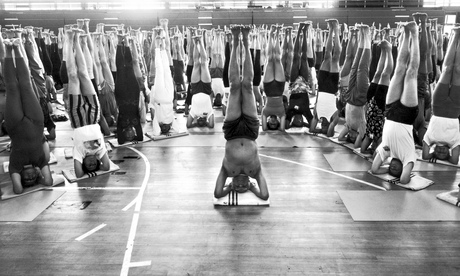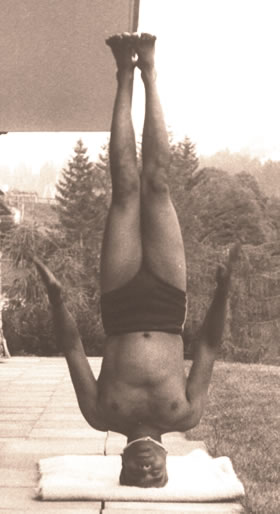how to do headstand (sirsasana)

 In comments past, Merka asked: “My vinyasa instructor LOVES inversions and headstands. However, I am slightly terrified of headstands because my arms are quite shaky when I do them. Do you recommend any arm exercises, in addition to downward dog, that would help build muscle? How do I encourage my body to relax when I’m in this position?”
In comments past, Merka asked: “My vinyasa instructor LOVES inversions and headstands. However, I am slightly terrified of headstands because my arms are quite shaky when I do them. Do you recommend any arm exercises, in addition to downward dog, that would help build muscle? How do I encourage my body to relax when I’m in this position?”
I’m going to backtrack on this, because it also relates to M’s comment on virtual yoga, and because it seems to me that there is a lot of mystique and self-worth tied up with sirsasana and other inversions in a yoga practice. For some reason, many people seem to feel that if they can’t or don’t do headstand, they aren’t really doing yoga. I’m not suggesting this is you, Merka. It just reminds me that I know so many students who are fixated on it to the point of taking away from their overall practice. Yes, it’s cool to go upside down and there are many benefits. But it’s also very dangerous to do improperly because it can put so much weight on the neck, and those dangers can far exceed the benefits.
When I started doing yoga, I was quite weak. I did yoga because it relaxed me, and I had no designs on ever doing headstand, armstand, or anything I deemed fancy. But over the years (two?), a regular, well-balanced yoga practice gave me the strength and balance to do them easily. It was a natural progression that felt neither dramatic nor effortful. And while I do practice headstand, I know much more accomplished practitioners than myself who don’t do headstand because of neck issues or other concerns. My point: if you don’t feel solid and safe in headstand, don’t do it. In this case, not doing headstand is being kind to yourself, and much more yogic.
So what do you do in class if everyone else is going up, and you feel inferior because you aren’t? Or feel like your being a wimp because

you could, but…? Find your breath. It’s much better to feel comfortable where you are then to hurt yourself. Headstand does not make you a better yogi or a better person. Practice dolphin to forearm plank, which most instructors teach as a strengthening option for students not going up. If you are going up, use a wall. If the teacher doesn’t provide that option, and you don’t feel comfortable going to the wall anyway, then skip it and practice at home.
I often skip headstand in class if the teacher doesn’t know me well (or vice versa) and it’s taught in the middle of the room because I have a subtle twist through my body (because of dominant sight in one eye since birth. It’s been there through development) that often isn’t noticed until headstand, and I’m not interested in having that conversation or being misguided while upside down and unsupported in the middle of a stranger’s class. So instead I do dolphin or whatever feels appropriate to me. And no one cares.

Different schools have different ideas about how headstand should be done. Where I first trained, it was said that students shouldn’t be near the wall because they’d come to depend on it. I thought that was silly (training wheels, anyone?) and never tried headstand there for that reason. No way was I trying that in the middle on the floor. Other schools, like Iyengar, believe that it’s fine to have the wall behind you and come up one leg at a time when you are learning, as long is it is slow and careful, the abs are engaged, the forearms press down, and there’s no hopping. (I don’t mean press your body against the wall. I mean the wall is a few inches a way in case you fall back.) This is how I learned. Then I switched to a school that insists on coming up two legs at a time to protect the neck (which took some acclimation) but walls are fine. Yoga Journal advocates the two leg method, but suggests that hopping is okay: “Take both feet up at the same time, even if it means bending your knees and hopping lightly off the floor.” After years of safely lifting on leg at a time, I hurt my neck by “hopping lightly” with both legs. I don’t think it’s a good idea. Neither is throwing one leg up at a time, of course, or letting your head and neck take the weight.
I’m not interested in saying one way is right and another is wrong. All schools and methods are valid for their own reasons. Find one (one) that works for you and a good teacher who can guide you. Personal issues and injuries aside, you will progress to headstand when you have the strength, and you will move that into the middle of the room with the confidence and grace that come from a regular yoga practice. As they say, “Chit happens.”
Funny how you wrote about not idealizing the pose alongside two incredibly alluring and intimidating pictures of it 🙂
I think the issues you speak of re: headstand apply to virtually all yoga poses. I find many people will practice a pose for the way it “supposed” to look like, rather than how it should feel from the inside. They end up straining themselves while holding their breath (just about the worst thing you can do from a yogic perspective). Of course, the balance is quite delicate between effort and ease, but in our society we tend to focus a lot more on the effort.
Relaxing is an especially important part of yoga, particularly in a challenging pose like headstand. The more relaxed you are within the pose, the more benefits you reap.
Oh, Ben, that was the point! (Did you read the caption? Though the second is pincha mayurasana/armstand.) 🙂
You bring the point back to relaxing, and M’s question was “how can I relax in the pose?” My answer was indirect. If you are comfortable and stable in the pose, you will relax, and this will come with practice and maybe to begin, with the stability of a wall behind you. I should say that the mind will relax. The body is not meant to be relaxed in headstand. It’s not rigid or strained, but the muscles are certainly engaged, and the forearms are grounding down into the floor to keep weight off the head and neck. The abs draw in. The tailbone draws up toward the heels. It’s work. As the saying goes, try find the point between effort and ease.
Thanks for the always great comments, Ben! Your new blog is fantastic! Everyone should check it out at: http://yogibenji.wordpress.com/
To further my argument, the other day my teacher said something to another student and she replied, “But I can’t do headstand yet.”
He said, “So what? It will come,” and went on.
Exactly.
The purity of your practice is very evident in reading this. You have so properly pointed out everything needed to be known to a student of yoga finding themselves in this place of should I, can I, how do I..? It felt like breathing fresh air after the rain falls on the foliage reading your answer to this person’s question. True yoga is not focused on asana in and of itself, this is a gross misunderstanding in our Western society, and it is so important to be aware of your body, your capabilities, and even your questions regarding your body’s ability and applying that appropriately to whichever class situation you may be in and the teacher’s acquaintance with your personal practice. When practicing yoga asanas on a regular basis, so many small places of challenge reveal themselves, and it is so so important know your personal boundaries, and know how to approach a boundary one is not sure of yet. Well presented, refreshing to see a student and surely teacher of yoga properly understand yoga first of all and also share and express it to others properly for safety, and ultimately growth.